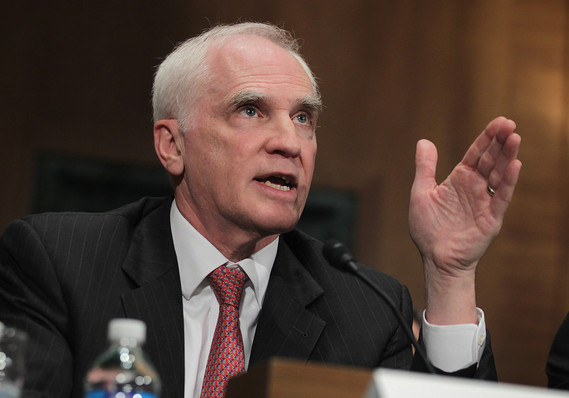 Getty Images
Getty Images Former Fed Gov. Daniel Tarullo on Thursday said the turmoil in the crucial short-term lending market in September raises a fundamental question for regulators — will the new rules put in place in the wake of the 2008 financial crisis exacerbate an “over-hoarding” of capital during market stress?
In the September crisis, interest rates on short-term “repo” loans spiked to 10% from under 2%, setting off alarm bells on Wall Street and in Washington.
Fed officials were caught off guard when banks like JPMorgan Chase JPM, +0.54% and Citigroup C, +0.65% did not move to take advantage of the high rates and lend excess funds to other firms. Instead, the Fed was forced to step in with restart-lending facilities not seen since the financial crisis.
Over the past two months, the Fed has lent more than $320 billion to the repo market.
In a discussion of the repo market stress, sponsored by the Brookings Institution, Tarullo said the episode raises question about an over-arching feature of the new rules — that the biggest banks must amass and hold a large quantity of liquid assets to ensure they can survive periods of stress.
While these rules counter the problem of banks “under-hoarding” of liquidity during normal times, it may also cause them to “over-hoard” during periods of market stress, Tarullo said.
“If every bank must sit on its pool of readily usable liquidity in anticipation of possible failure, the result could, in periods of stress, be a decidedly suboptimal [outcome] that starves an already strained financial system of needed liquidity,” Tarullo said.
Patricia Mosser, director of the MPA program in economic policy management at Columbia University, said it would be worrisome if Tarullo was right.
If liquidity hoarding would ever occur in a “true period of market stress, it would be a complete disaster,” Mosser said.
The need to provide liquidity would fall on shadow banks, she noted.
The Fed and Treasury Department are reviewing the episode to see what changes should be made in the funding markets.
Some experts have argued the repo market is “broken” and the Fed hasn’t come up with a workable solution.
Read: The repo market is ‘broken’ and Fed injections are not a lasting solution
Tarullo and other experts at the discussion disagreed, saying the episode was not hugely troubling and the volatility was a useful episode for regulators.
Short-term funding markets have rarely been volatile since the financial crisis because the Fed was buying assets to keep down long-term interest rates.
Tarullo will be a key voice in the upcoming debate because he was the Fed’s point person on bank regulation from 2009-’17.
He suggested an alternative would be instead to make sure banks have “sustainable funding practices.” But moving away from the mandates that banks hold pool of liquidity will take time, he said.
In the meantime, Tarullo said he agreed with Jamie Dimon, JPMorgan’s CEO, who has argued his bank couldn’t lend out money during the repo market stress because of the myriad of Fed capital requirements. Randal Quarles, who took Tarullo’s place as the Fed’s point person on bank supervision, has also agreed with Dimon.
See: Fed’s Quarles agrees with JPMorgan CEO Dimon on cause of repo-market turmoil
“It seemed to me Jamie had a very plausible account of what part of regulation might actually be playing a role and that one, I think at least is worth talking about,” Tarullo said.
div > iframe { width: 100% !important; min-width: 300px; max-width: 800px; } ]]>










Add Comment